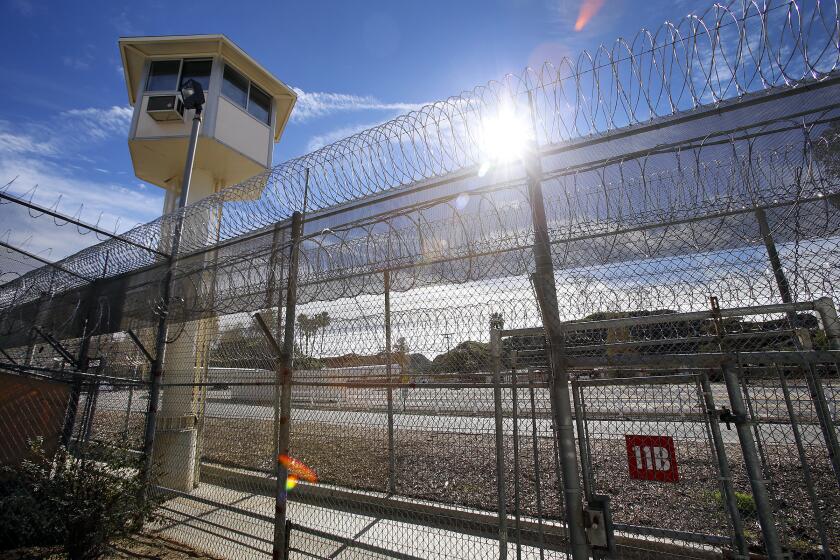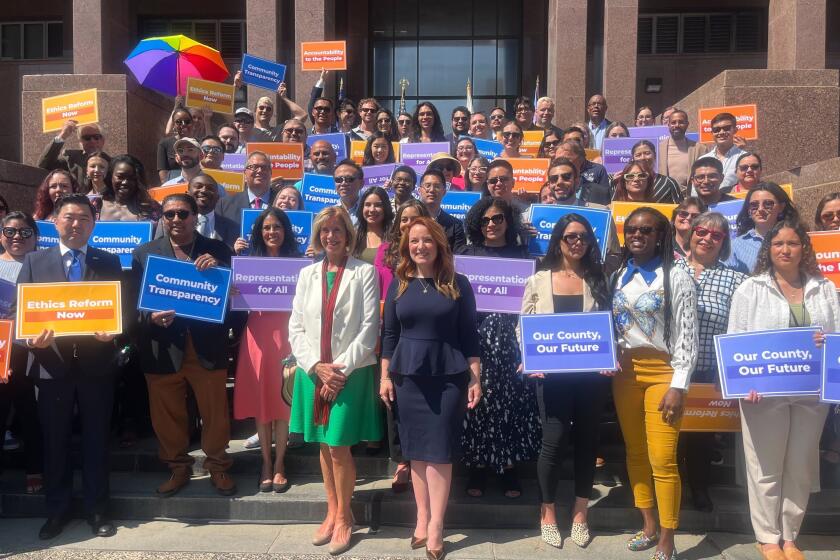Calls for ‘Passive Park’ Start an Active Debate : Recreation: Some near Santa Ana’s Fisher Park want changes to make it less likely to attract crowds. Others want it left alone.
- Share via
SANTA ANA — For years, the wedge-shaped small park served its north Santa Ana community well. Its log cabin, barbecue pit and picnic tables offered the perfect setting for birthday parties, Scout meetings and other neighborhood events.
Some residents near Jack Fisher Park, however, say they are worried that too many “outsiders” are using the park and bringing problems such as overcrowding, litter, loud music and graffiti to the neighborhood.
As a result, some residents and city officials are finding themselves at odds over competing demands for the use of scarce public parkland in a densely populated part of Orange County. Many of the park’s neighbors say they want a more private, uncrowded preserve there. But city recreation officials say the park’s popularity is proof of the need to leave it as is.
The Fisher Park Neighborhood Assn., unsuccessful in attempts to limit the use of the park, has hired a consultant--using city funds--to explore turning the open space into a “passive park,” perhaps by creating botanical gardens, removing the picnic tables or installing playground equipment for toddlers only.
“What we see is a wonderful space that can be made better--a quiet kind of place, a contemplative-type park,” Dennis Wootan, chairman of the neighborhood association, said recently.
But other neighborhood residents want the park to stay as it is, and city staffers agree.
“You can talk about litter, and you can talk about parking and overcrowding and things like that,” said Barbara Russell, a resident who is against changing the park. “But I think there’s an underlying feeling that this is no longer ‘our neighborhood’ that we can control, that there are large numbers of people, and with large numbers of people come problems--gangs, graffiti--large problems coming across 17th Street we had not seen before.”
Councilman John Acosta was more blunt: “The thrust of the whole issue is the fact that (the park) is primarily used by Hispanic families. It becomes kind of an elitist attitude as far as I am concerned.”
The issue came up briefly during a recent City Council meeting, when Acosta raised the concerns of residents who oppose redesigning the 1 3/4-acre park, which was named after a World War I veteran from Santa Ana.
Several months ago, Acosta said, residents had asked if there was a way to restrict use of the park to neighborhood residents. But the city attorney ruled that would be illegal, the councilman said.
Allen Doby, director of recreation and community services, also said he had heard a suggestion from some residents that the city sell the park to the neighborhood association.
“They wanted to use it as a private-use park, and we indicated to them at that time that it was not for sale because it was a very important piece of recreational area for the city of Santa Ana,” Doby told the council.
Open space is a valuable commodity in a city that has only 1.02 acres of parkland for every 1,000 residents. The city’s open-space goal is 2 acres per 1,000 people, which is still at least 1 acre below the Orange County average, city officials said.
Elise Smith, who lives near the park, which is near the intersection of Memory Lane and Flower Street, said she can sympathize with residents concerned about preserving their neighborhood. However, she said, residents favoring changing the park are “discriminating against everyone who does not live within a 1-mile radius of this park, and I just don’t see how you can do that.”
Barbara Considine, a member of the city’s Parks Board, said she has made numerous visits to the park on weekends to evaluate residents’ concerns. But so far, she said, she has not seen the problems reach a level that she believes would warrant a redesign.
“I cannot take on reasons that they don’t articulate,” Considine said. “If I don’t see them substantiated, then I don’t understand why they think the park should be changed to a passive park.”
But neighborhood association officials said the problems are real to those whose homes are next to the park. They described the increasing number of parking problems, the transients who use the park and the unlocked restrooms, and the fear that the park’s current design provides cover for drug dealers.
They also denied that they are trying to discriminate against any particular ethnic group.
“The (neighborhood) group is a group of individuals, and when you talk about feelings, that’s an individual feeling,” Wootan said. “That’s not really an issue with me.”
The park was one of the major reasons the neighborhood formed an association last year, said Robert Lascelles, the association’s first chairman.
If a redesign “reduces the number of people that are using it--I don’t care where they are coming from--that’s fine,” Lascelles said. “What we are trying to do is reduce the over-usage of the space.”
Because of the group’s concerns, $35,000 was set aside in this year’s city budget for security lighting at the park, City Manager David N. Ream said.
But that plan, along with other improvements proposed for the public restrooms, has been put on hold pending the outcome of the consultant’s study, city staffers said. About $2,500 from the lighting fund is being used to pay the consultant. However, no other funds have been set aside for a park redesign, city officials said.
“What we are doing is facilitating the neighborhood effort to develop an alternative plan for Fisher Park,” Ream said.
Any plans to redesign the park will have to be approved by the Parks Board, the Planning Commission and the City Council, city officials said.
More to Read
Sign up for Essential California
The most important California stories and recommendations in your inbox every morning.
You may occasionally receive promotional content from the Los Angeles Times.













